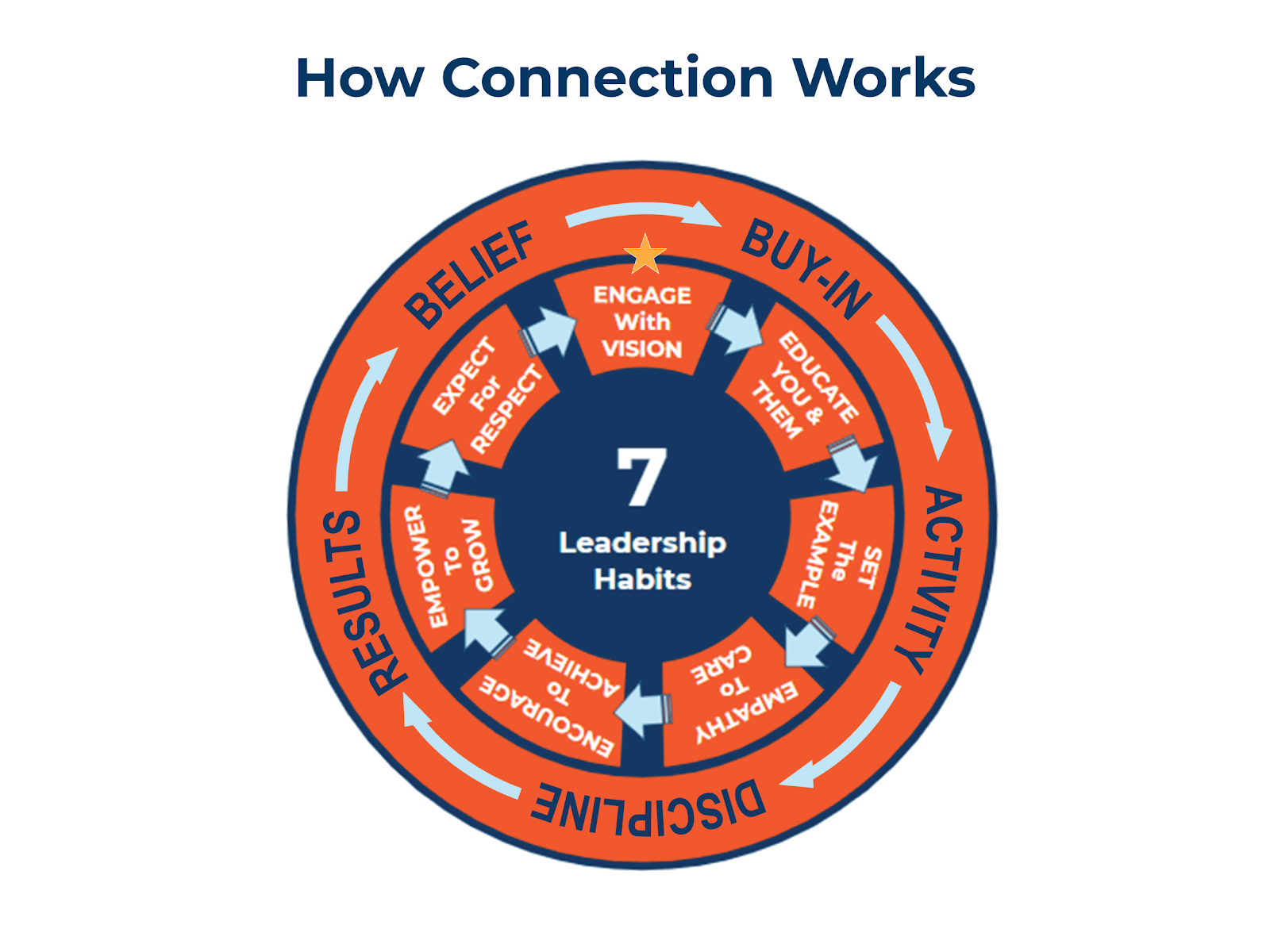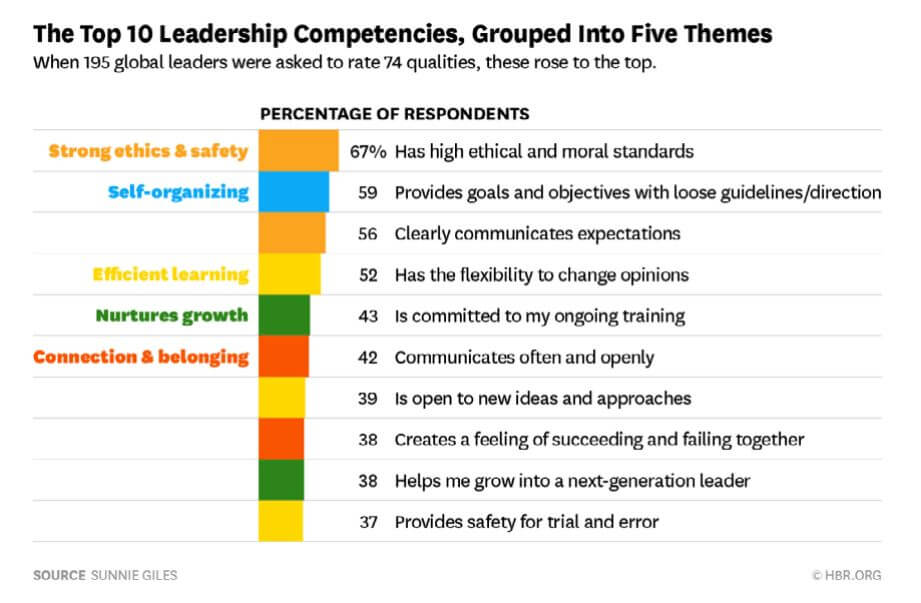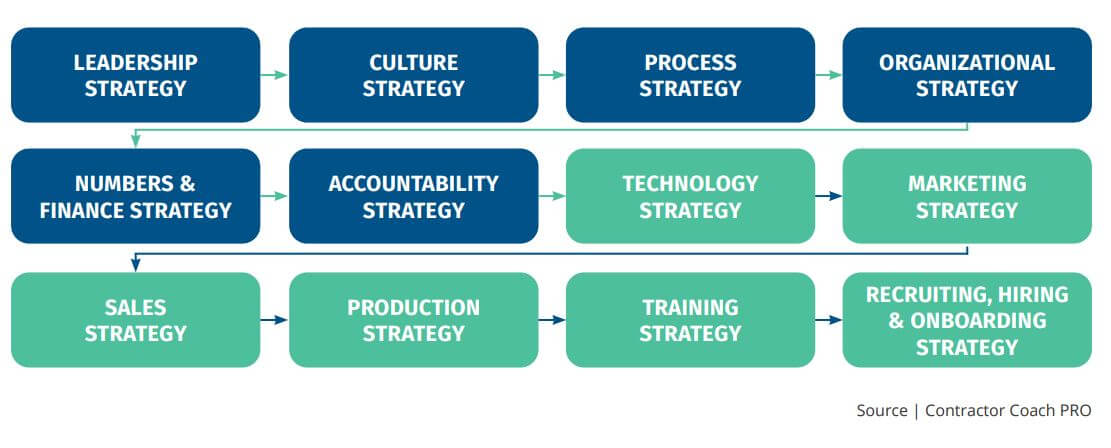
Font: Contractor Coach Pro
Two Sides of Construction: Operational and Foundational DNA
The blueprints developed by Johnson’s company, outlines necessary elements for both Operational and Foundational DNA in your construction business.
Foundational DNA is more business-oriented and includes:
- Leadership
- Culture
- Organization and HR
- Finance • Accountability
- Processes
There are six key elements to Operational DNA, according to this blueprint:
- Technology
- Marketing
- Sales
- Production
- Training
- Recruiting and Onboarding
Leadership
What Johnson refers to as “The Big One,” great leadership is the key to success. But there is a difference between being a boss or business-owner and being a strong, effective leader. Harvard Business Review did a study and found that global leaders rated the top 10 attributes of a strong, effective leader as someone who:
- Has high ethical and moral standards
- Provides goals/objectives with loose guidelines/direction
- Clearly communicates expectations
- Has the flexibility to change opinions
- Is committed to employees’ ongoing training
- Communicates often and openly
- Is open to new ideas and approaches
- Creates a feeling of succeeding and failing together
- Helps employees grow into a next-generation leader
- Provides safety for trial and error
In much the same way, Johnson advises his clients there are seven steps to being a great leader.

1. Engage with Your People with Vision
Ensure your employees clearly understand the vision of your company and why your overall goals are important as an organization. Make sure they are aware of how their role within your company will help your company reach the goals you’ve established. This gets you, as a leader, buy-in from your employees.
2. Educate Yourself and Them
Don’t get stuck doing the same things and expect growth. Rather, invest in learning for both yourself and your employees. Make sure everyone has the right tools they need to get their jobs done and never stop learning and improving yourself.
3. Set the Example
If you expect your employees to work hard, you have to set an example by working hard, too. How you carry yourself within your role as a leader, will set the tone for your employees.
Be available to show your employees things they didn’t know. Be consistent and let them see that you are as committed to their success as you are the company’s success.
Make sure you’re setting the right examples, making the right decisions, and willing to get your hands dirty if the opportunity presents itself. Accept your mistakes and take responsibility for them. In Johnson’s words: “You are what your people will be.”
4. Empathy to Care
Putting yourself in others’ shoes is the best way to understand empathy. And when you incorporate empathy in your leadership repertoire, you improve your leadership skills. In today’s workforce, leaders need to have empathy for their workers. The trick, according to Johnson, is to make sure you find a balance so you’re not enabling your employees to take advantage of you. As an example, Johnson says if you feel like you cannot fire someone, there’s a chance you’re being too empathetic and you may need to step back and evaluate yourself.
Conversely, being empathetic also means understanding they are learning and being willing to give them the opportunity to make mistakes as long as they’re learning from them or acknowledging their growth.
5. Encourage to Achieve
Of course, leaders will always notice a mistake or error. Even if someone does something correctly 99 times, they will always notice the 100th time if it’s messed up. When leaders focus more on the positives, it encourages your employees to do more good.
6. Empower to Grow
Employees want to feel secure and appreciated in their jobs and they want to feel like they are contributing to the growth of the company. Keeping talent is a challenge, especially in construction and trades, so it’s critical that you are allowing them the opportunities to grow in their careers.
If you have an employee who is talented with one skillset, encourage them to step out of their comfort zone and learn another skill set. This, Johnson says, doesn’t have to be something major. It could be a simple training or role-playing exercise that gets them started with learning something new and lets them continue to learn more and more about this new skill set until they have it mastered.
This encourages engagement and loyalty to your company. Make sure they know they are valued and have growth opportunities for doing great work.
7. Expect for Respect
Once your employees have seen you lead by example and are clear on the expectations you have of them, they should be committed to helping your company grow because they are a part of a bigger picture.
However, if you have employees underperforming, they could be taking advantage of you and/or your business. This is where accountability comes in. If you’re not holding under-performers accountable, you’re going to start losing the respect you’ve carefully built.
Following these seven rules consistently, they will become a habit and you, in turn, will become a greater leader and retain your best employees. This is an instrumental part of growing your business because you’re not going to be as likely to be scrambling to find workers.
Foundational DNA
While leadership is the most important aspect of foundational DNA, there are several other things that contribute to creating the base and determining the strength of your business. Great leadership is where it starts. Johnson advises, once they have their leadership skills honed, business owners should follow a clear blueprint to success and growth.

Culture
Your culture has to do with why you’re doing what you are doing. It’s establishing your reason and, thus, the reason your employees do what they are doing. Determine five key factors that your company culture is built around:
- Dream
- Vision
- Purpose
- Core Values
- Mission
These things will help you set the right goals - both short- and long-term - so you can begin to build your company strategically.
Process Strategy
Create processes around common tasks and jobs to save time and be prepared for any unexpected issues or challenges. Your processes should make your work life easier to be consistent and outline how things should be handled by everyone within the organization.
Organizational Strategy
Create processes around common tasks and jobs to save time and be prepared for any unexpected issues or challenges. Your processes should make your work life easier to be consistent and outline how things should be handled by everyone within the organization.
Numbers and Finance Strategy
Cash flow is the most common problem causing startup and small construction companies to fail within five years. That’s why you have to have a financial strategy to stay on top of your assets and liabilities. Determine if you want to do your bookkeeping yourself, use software, or outsource it.
Make sure you have all of the reports you need to have an accurate picture of your financial situation. Such reports might include:
- Profit and Loss (P&L)
- Balance Sheet • Cash Flow
- Trade Profit Analysis
- Sales Team Analysis
- Marketing ROI
Make sure you have accurate data when running these reports so you don’t end up in the red, unexpectedly.
Accountability Strategy
As a leader, you’ve set your expectations but have you done it thoroughly so your workers know exactly what is expected of them? It’s about more than just telling them a job needs to be done. There are ways to measure and track how things are done, who did them, and how they did.
Consider implementing KPIs (Key Performance Indicators) so you can literally have a measurement of how things are going. Make sure your employees understand the minimum, maximum, and expected results and provide accurate job descriptions so there is no misunderstanding. Make sure your workers are adequately compensated and given the right tools to complete the jobs they’re sent to do and implement a review process to gauge how well (or not) they are doing.
Operational DNA
The bridge between foundational and operational DNA, according to Johnson, is technology. He advises if it doesn’t make you money, save you time, or make your work simpler, it’s probably not the best option for you. But automating processes and workflows with technologies that do all of these things, are proven ways to stay profitable and continue to grow.
Technology Strategy
Consider all the steps in your foundational and operational DNA and how technology can marry them and create smoother workflows. Using a time tracking application that allows you to communicate, create reports, track customers, calculate labor costs, perform job costing, and run payroll is an example of how technology can streamline and simplify your operations.
Marketing Strategy
You can’t just go knocking door-to-door to get leads. Technology has changed the landscape of how today’s contractors can reach potential new leads. The trick is to build a strategy around what you can do and what is within your budget.
There are direct ways (telemarketing, canvassing, business development, maintenance programs, networking, etc.) and indirect ways (guerrilla marketing, third-party services, technology like Google, social media, etc.) you can market your company and/or services.
A lot goes into marketing so it’s important to have a clear understanding of key elements before stepping into a marketing role.
Sales Strategy
The initial key to building a successful sales strategy is understanding your ideal customer and their core problems. From there, you develop a unique proprietary solution that will serve them better than anyone else.
This strategy should include a process for how your value proposition is presented to maximize the communication of that value and give you something to train your people on, to increase your construction company’s sales.
Production Strategy
The best customer service comes from companies that view what was promised as the starting point for taking care of the client. Production isn’t simply the delivery/ installation of your product; it’s the continuation of the client experience and another opportunity to “wow” your customers. This is also where most companies will receive the lowest grades from their clients.
All good production strategies start with a clean and detailed sales process. If this is done right then production should have the ability to focus on going above and beyond rather than cleaning up after the sales team.
Training Strategy
The most powerful training strategies have two main parts to them:
- The quick start: This is the bare minimum needed to get someone from 0 to proficient/successful at their job. This is especially important on the sales side being that sales is generally a commission-based role and most people cannot go without a paycheck for very long.
- Ongoing training: Ongoing training offers the opportunity to increase our teams’ skills and proficiency. This will also give the ability to fill in the gaps that our quick start training didn’t cover.
These parts are not able to work independently of each other. If you employ only one of these training methods you will either have a stagnant team that isn’t getting better or it will take far too long to get people up and running and your turnover will be high.
Don’t forget to practice, practice, practice.
Recruiting/Hiring/Onboarding Strategy
Recruiting and hiring is the same as marketing and sales. Attracting the right people comes down to effectively implementing, and communicating your company’s culture. Those that your culture resonates with will want to be part of your team.
Get a clear understanding of the type of person that you’re looking for based on the role you are trying to fill. What attributes and skills do they need to have and how can we measure and score those? If you can answer those questions, then you should be able to build an effective ad campaign, interview process and questions and scoring method for your candidates.
One pro tip here: Make the onboarding process something really special. It’s a privilege to get to work at your company, make them feel like they won the lottery!




